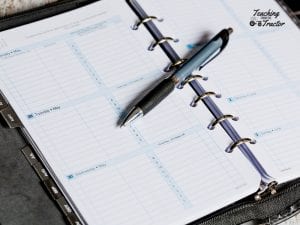So call me a nerd, but preparing our homeschool schedule for the year is one of my favorite things to do! Maybe it’s the new year full of possibilities. Maybe it’s because I know how much of a sanity saver it will be for me once it is complete. Either way, I look forward to it every summer!
I applaud those that homeschool effortlessly without a schedule and simply enjoy the flexibility that homeschooling has to offer. However, that is definitely not me. I NEED to know what should be accomplished each and every day. I need to know we are on the right track and not falling behind. With that being said, I know things do not always go according to plan so do schedule some some flexibility in.
I am preparing to schedule our 3rd grade year. I will be using the five steps below to make this process simple and smooth.
Step 1: Decide on Number of Days/Weeks
 Some people choose a certain number of days and others decide on a certain number of weeks. Most of our homeschool curriculum schedules out 36 weeks, so we typically go with 36 weeks or around 180 days.
Some people choose a certain number of days and others decide on a certain number of weeks. Most of our homeschool curriculum schedules out 36 weeks, so we typically go with 36 weeks or around 180 days.
It’s also very important to make sure you meet your state’s homeschool requirements. Some states require a certain amount of hours, days, or both. For all my homeschool legal requirements, I turn to HSLDA (Home School Legal Defense Association). Here is the link to find out what the laws are in your state: https://hslda.org/content/laws/
Step 2: Schedule Your Days Off for the Year
Whether you homeschool year round or take a summer break, the next step is to schedule your days off. This includes holidays and vacations. I also try to schedule at least one day a month off where we can catch up if needed.
 We typically take a two week vacation in the winter, so I just schedule two weeks off in February. This way we do not have to worry about catching up once we return, or doing schoolwork on vacation. Once I have a school end date or beginning date in mind, this allows me to determine when we either need to start school or when we will finish the year.
We typically take a two week vacation in the winter, so I just schedule two weeks off in February. This way we do not have to worry about catching up once we return, or doing schoolwork on vacation. Once I have a school end date or beginning date in mind, this allows me to determine when we either need to start school or when we will finish the year.
Our family does take a break in the summer so that we can help with the farming. I try to keep our schedule similar to our local school district. That way if the neighborhood kids come over to play on a day off, my kids are free to play.
Step 3: Figure the Number of Lessons for Each Subject
 Next, I go through each subject and write down the number of lessons each subject has. I skim through the lessons as well to determine if one day for each lesson is adequate. If not, I make a note to schedule them out over a couple of days.
Next, I go through each subject and write down the number of lessons each subject has. I skim through the lessons as well to determine if one day for each lesson is adequate. If not, I make a note to schedule them out over a couple of days.
If the subject is not divided out by lessons, then I figure out the best way to split it up over the course of the year. This may be by chapter, pages, units, etc.
The majority of our curriculum has either a suggested schedule or some type of recommendation for scheduling it. For example, we use the Apologia Young Explorer Series for our science and they have a recommended schedule that is very helpful when scheduling it out for the year.
The majority of our curriculum also comes from Timberdoodle. They have a very helpful custom scheduler that comes free with any of their kits. It allows us to put in all of the curriculum we purchased through them and also the length of our school year. It then automatically gives me a checklist with how many pages, chapters, lessons, projects, etc need to be done each week in order for us to be finished by the end of our school year.
These are all helpful tools when it comes to scheduling out our homeschool year and I refer to them often. The weekly checklist may be adequate for some, but I prefer to take it one step further. I like to have the exact pages and things that need to be done each day of every week.
Step 4: Set Your Weekly Schedule
Now that you know how many lessons each subject has, you can easily determine the best weekly schedule for your year. For instance, if a subject has 36 lessons and can be taught in one day, then you simply schedule that subject for once a week on a 36 week schedule.
If a subject maybe needs to be taught 1 ½ times a week, then I schedule in something smaller every other week. For example, this year we did Story of the World Volume 2 which had 42 chapters. This was too many to make it work with once a week and too few to make it work with twice a week. So I scheduled it out twice a week and then every other week, I scheduled it once a week and filled in that second day with an art curriculum that had 8 total projects to be completed for the year.
The main subjects are scheduled either daily or a couple times a week. I try to schedule in something that my son loves doing every day. This varies from STEM to art to thinking games. In the end, my weekly schedule is pretty even throughout the week, with Friday’s being lighter because we have our homeschool co-op that day.

Our 1st Grade Daily Schedule
Step 5: Schedule Each Subject
 Now I grab my homeschool planner and simply choose a subject and schedule it for the entire year. Once I am finished with one, I grab another subject and do the exact same thing. I usually do one subject in a sitting and then take a break, since it takes a bit of time to get one subject done. I do the different subjects in different colors. So I do all math in red, all language arts in blue, bible in green, and so on.
Now I grab my homeschool planner and simply choose a subject and schedule it for the entire year. Once I am finished with one, I grab another subject and do the exact same thing. I usually do one subject in a sitting and then take a break, since it takes a bit of time to get one subject done. I do the different subjects in different colors. So I do all math in red, all language arts in blue, bible in green, and so on.
In my detailed schedule, I include the lesson number, the teacher’s manual pages for that lesson, the textbook page numbers if there are any, and the activity book pages that need to be completed. Here is an example of how a bible lesson looks in my homeschool planner:
BT Lesson 125 pg. 270-272 ; WT pg. 183-184
I can look at this and see that we are doing Bible Truth lesson 125 and know the page numbers that follow are the pages in the teacher’s manual. The WT stands for worktext so I know those are the pages my son needs to complete for that lesson. Once this is complete, it gets highlighted it in my planner so I know it is done.
Ready to Start Your Homeschool Year
With the year now planned out in detail, I feel so much more confident starting our homeschool year! This helps when I go to prep for the upcoming week, and helps me to not waste time each day trying to figure out what needs to be done. While it does take some time initially to schedule the homeschool year, it definitely saves time in the long run!
I hope you found these steps helpful! Please let me know if you have any questions! Happy scheduling!
